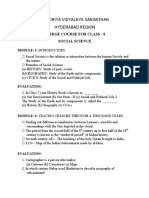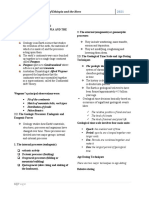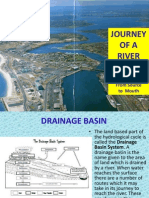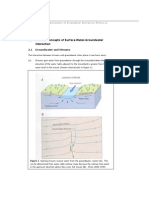0 ratings0% found this document useful (0 votes)
50 viewsGeography
Geography
Uploaded by
Syed Ali HaiderThis document provides information about geography from a 4th grade social studies textbook. It includes definitions of key geographic terms like continent, ocean, map, climate, weather, as well as descriptions of landforms and natural disasters in Pakistan. It also lists safety measures for earthquakes and advantages of census. Questions at the end test understanding of these concepts and terms.
Copyright:
© All Rights Reserved
Available Formats
Download as PDF, TXT or read online from Scribd
Geography
Geography
Uploaded by
Syed Ali Haider0 ratings0% found this document useful (0 votes)
50 views7 pagesThis document provides information about geography from a 4th grade social studies textbook. It includes definitions of key geographic terms like continent, ocean, map, climate, weather, as well as descriptions of landforms and natural disasters in Pakistan. It also lists safety measures for earthquakes and advantages of census. Questions at the end test understanding of these concepts and terms.
Original Description:
chapter
Copyright
© © All Rights Reserved
Available Formats
PDF, TXT or read online from Scribd
Share this document
Did you find this document useful?
Is this content inappropriate?
This document provides information about geography from a 4th grade social studies textbook. It includes definitions of key geographic terms like continent, ocean, map, climate, weather, as well as descriptions of landforms and natural disasters in Pakistan. It also lists safety measures for earthquakes and advantages of census. Questions at the end test understanding of these concepts and terms.
Copyright:
© All Rights Reserved
Available Formats
Download as PDF, TXT or read online from Scribd
Download as pdf or txt
0 ratings0% found this document useful (0 votes)
50 views7 pagesGeography
Geography
Uploaded by
Syed Ali HaiderThis document provides information about geography from a 4th grade social studies textbook. It includes definitions of key geographic terms like continent, ocean, map, climate, weather, as well as descriptions of landforms and natural disasters in Pakistan. It also lists safety measures for earthquakes and advantages of census. Questions at the end test understanding of these concepts and terms.
Copyright:
© All Rights Reserved
Available Formats
Download as PDF, TXT or read online from Scribd
Download as pdf or txt
You are on page 1of 7
CHAPTER #6 GEOGRAPHY CLASS:4th
Give short answers of the following questions:
Q:1 What is globe?
Ans: The word globe is taken up from the Latin word “Globus” which means a
round mass or sphere. In other words a globe is a model of the Earth.
Q:2 Differentiate between continent and ocean?
Ans:
CONTINENTS OCEANS
Land masses on the Earth’s surface are The bodies of salt water are called
called continents. oceans.
There are seven continents: There are five oceans:
(i) North America (i) Pacific ocean
(ii) South America (ii)Atlantic ocean
(iii) Europe (iii) Indian Ocean
(iv)Africa (iv)Southern ocean
(v) Asia (v) Arctic ocean
(vi)Australia
(vii)Antarctica
Q:3 Give the uses of map?
Ans: Maps are used:
i. To find locations of different places
ii. To measure the landforms
iii. For defence purposes
iv. for tourism and travelling
v. for historical perspective
vi. for agricultural and financial matters
vii. for planning and development
Q:4 Define day time population and night time population?
Subject: Social Studies Typed By: Syed Ali Haider
CHAPTER #6 GEOGRAPHY CLASS:4th
Day Time Population Night Time Population
The term day time population refers to The term night time population refers
the number of people that come into to the resident population present
area for work during day time. For during the evening and night time
example, population in Islamabad hours.
during day time.
Q:5 What is compass?
Ans: There are 16 directions in a compass. The word NEWS stands for:
N=North E=EAST W=West S=South
East and West are the directions opposite to each other while north and south are
opposite to each other. Qibla compass is a modified compass used by Muslims to
locate the direction of Qibla.
Q:6 Define deforestation?
Ans: Deforestation refers to cutting of trees without growing more trees. There are
many reasons for deforestation such as:
(i) Forests are cut down to clear land for agriculture, factories, roads, rail tracks
and mining.
(ii) Trees are also cut down to get wood to make homes, furniture and other things
and for local fuel.
(iii) Due to over population more place is required for settlement of new people so
forests are cut to get more area.
Q:7 Which crops are sown during Kharif season?
Ans: Kharif crops are sown during kharif season between April and June and
harvested between October and December. Kharif crops include rice, cotton,
sugarcane, maize etc.
Q:8 Which are main industries of Pakistan?
Ans: Following are the main industries of Pakistan:
(i)Textile Industry (ii) Sports Industry (iii) Cement Industry
(iv) Sugar Industry (v) Fertilizer Industry (vi) Iron and Steel Industry
Subject: Social Studies Typed By: Syed Ali Haider
CHAPTER #6 GEOGRAPHY CLASS:4th
(vii) Mining Industry
Q:9 Differentiate between weather and climate?
Weather Climate
Weather is a day-to-day condition of Climate is an average weather
the atmosphere in a region. Weather is condition of a place for a long period
not the same everywhere. It may be hot of time. Pakistan has dry and extreme
and sunny in one part of the world but climate. Siberia has snowy climate and
freezing and snowy in another. Singapore has a rainy climate.
Q:10 Define local weather?
Ans: The weather of a particular locality is called local weather. For example, it
may be hot and sunny weather in Lahore but it may be cloudy in Karachi. There
are several factors that affect weather. Some important elements of climate are:
There are several factors that affect weather:
(i) Temperature (ii) Wind (iii) Humidity (iv) Precipitation (v) Air Pressure
Answer the following questions in detail:
Q:1 Describe the key elements of the map in detail?
Ans: The key elements of the map that assist the map readers are:
(i) Title (ii) Symbol (iii) Directions
(iv) Scale (v) Legend or key (vi) Border
Title explains the purpose of the map. For example, weather map, population map,
physical map, road map etc.
In a map, you cannot show details of each object or feature in writing instead
symbols are used.
Directions are bearing. They are angular distances. There are four basic cardinal
directions or cardinal points:
Subject: Social Studies Typed By: Syed Ali Haider
CHAPTER #6 GEOGRAPHY CLASS:4th
(i) North (ii) East (iii)West (iv) South
East and west are the directions opposite to each other while north and south are
opposite to each other.
There are 16 directions in a compass.
Scale is a ratio between the ground distance and map distance.
Legend or key is an explanation of the meaning of all the symbols, colours and
signs.
The outline or frame surrounding the map is called border.
Q:2 Explain landforms of Pakistan?
Ans: The different physical features of the Earth are called landforms of the Earth.
Pakistan is a beautiful collaboration of different landforms. Major landforms of
Pakistan are as under:
(i)Mountains (ii) Plateaus (iii) Plains (iv) Deserts (v) Valleys
MOUNTAINS:- Mountains are the raised part of the Earth’s surface.
The mountain ranges of Pakistan are:
(i) Karakoram (ii) Hindukush (iii) Himalays
PLATEAUS:-Plateaus is a flat area between the mountains.
Pakistan has two Plateaus:
(i) Potohar Plateau
(ii) Balochistan Plateau
The world’s second largest salt mine Khewra is situated in Potohar.
PLAINS:- Plains are flat surface of land. Upper Indus, Lower Indus and Indus
delta are the major plain of Pakistan.
DESERTS:- A desert is a hot dry place with little or no rain.
The deserts in Pakistan are:
(i)Thal Desert (ii) Thar Desert
VALLEYS:- A valley is a low area between higher lands such as mountains.
Subject: Social Studies Typed By: Syed Ali Haider
CHAPTER #6 GEOGRAPHY CLASS:4th
The valley of Pakistan are:
Swat, Chitral, hunza, Kashmir etc.
There are two types of valleys:
V-shaped valley:
v-shaped valleys are formed by following rivers.
U-shaped valley:
U-shaped valley are formed due to the movements of glaciers.
Q:3 Describe elements of climate?
Ans: The following are the most important elements of climate.
(i) Temperature (ii) Rainfall (iii) Wind
Temperature that is scale of the degree of heat and cold. It is measured in degree
centigrade or Fahrenheit.
Rainfall is the release of water from the clouds is called rain.
Wind that is defined as the movement of air. Wind always blows from area of high
pressure to area of low pressure. It affects the weather condition.
Q:4 What is natural disaster? State safety measures before, during and after
earthquake?
Ans: Natural events that cause great damage or loss of life are called natural
disasters. They include floods, earthquakes, cyclones, avalanches, volcanic
eruptions, landslides, droughts and famine etc.
SAFETY MEASURES BEFORE, DURING AND AFTER EARTHQUAKE
Earthquake is unpredictable and can strike with enough force to bring building
down. Following are the basic safety measures taken before, during and after
earthquake.
1. Locate a place in the house where you can go in case of an earthquake. It should
be a spot where nothing is likely to fall on you, like a door frame.
2. If possible, quickly open the door for exit.
3. Protect your head, face and eyes with your arms. ‘
Subject: Social Studies Typed By: Syed Ali Haider
CHAPTER #6 GEOGRAPHY CLASS:4th
4. Find a clear and open spot away from buildings, trees, power lines and light
poles.
5. Stay out in the open place until the shaking stops.
6. Do not turn on the main switches for electricity, gas or water. Check for any
damages or leakages and then turn them on.
Q:5 Write short note on:
(a) Advantages of census
Ans: Census is a count of the population of a country. During census, information
about people living in a country is collected like actual number of people living in
each house, their ages, gender, religions, occupations and education etc. Such
information is called data.
The information or data collected by census helps the government in planning for
starting development programs and arrangement of resources.
Q: Write short note on:
(b) Avalanches
Ans: Avalanches are very fast flow of large amount of snow and ice down a
mountain slope. It is also called a snow slide. Avalanches occur when the weight
of the snow becomes more than its slopes. It can start due to any sudden shock,
sound and movement of ice.
Write “Yes” or “No”
(1) Longitudes are drawn from north to south poles. Yes
(2) Rabi season starts between April and June and ends between October and
December. NO
(3) Mining is the extractions of minerals and metals from the Earth. Yes
(4) Climate is a day to-day condition of the atmosphere in a region.NO
(5) Natural events that cause great damage or loss of life is called natural disasters.
Yes
(6) A count of the population of a country is called census. NO
Subject: Social Studies Typed By: Syed Ali Haider
CHAPTER #6 GEOGRAPHY CLASS:4th
(7) Rainfall is the movement of air. NO
Tick the correct option.
(1) Land masses on the Earth’s surface are called
(a) Continents (b) Oceans (c) Deserts (d) Mountains
(2) __________ is a model of Earth.
(a) Compass (b) Landform (c) Map (d) Globe
(3) It explains the purpose of the map.
(a) symbol (b) border (c) title (d) direction
(4) ________ is the cutting of trees.
(a) population (b) census (c) deforestation (d) agriculture
(5) It is our daily consumable product.
(a) coal (b) oil (c) gypsum (d) salt
(6) The process of cultivation of land or soil for production purposes is called.
(a) mining (b) deforestation (c) agriculture (d) industry
(7) The total number of people living in an area, city, country of the world at a
specific time is called:
(a) census (b) population (c) migration (d) avalanches
(8) The instrument used to record the earthquake is called:
(a) anemometer (b) rainguage (c) thermometer (d) seismograph
Subject: Social Studies Typed By: Syed Ali Haider
You might also like
- Grade 4 TH Final TermDocument5 pagesGrade 4 TH Final Termhummera JabeenNo ratings yet
- Bridge Course For Class 8Document12 pagesBridge Course For Class 8KHUSHI 7BNo ratings yet
- Major LandformDocument12 pagesMajor LandformMohd. JavedNo ratings yet
- NCERT Solutions For Class 6 Social Science Geography Chapter 6 Major Landforms of The Earth - ANSWER KEYDocument9 pagesNCERT Solutions For Class 6 Social Science Geography Chapter 6 Major Landforms of The Earth - ANSWER KEYsonia keniNo ratings yet
- Class 6Document6 pagesClass 6Shreya GuheNo ratings yet
- Half Yearly Paper 2020 XiDocument6 pagesHalf Yearly Paper 2020 Xiyanusurya1No ratings yet
- Social Studies Class IV Mid Term Teaching MaterialDocument16 pagesSocial Studies Class IV Mid Term Teaching MaterialMOHAMMAD FASIH HAIDERNo ratings yet
- Syllabus S.ST For Class FiveDocument10 pagesSyllabus S.ST For Class FiveShahzaib AhmadNo ratings yet
- Class 5 Social Studies Unit1 and 2Document7 pagesClass 5 Social Studies Unit1 and 2sanaazhar227No ratings yet
- Short Questions of Cahapter 4Document10 pagesShort Questions of Cahapter 4Izaan AbroOfficialNo ratings yet
- ICSE Class 6 Geography Sample Paper Set 1Document4 pagesICSE Class 6 Geography Sample Paper Set 1ahdusNo ratings yet
- ICSE Class 6 Geography Sample Paper Set 1Document4 pagesICSE Class 6 Geography Sample Paper Set 1dipayanrcNo ratings yet
- Gr.6 EV1 - Revision Worksheet - 25 - 2Document7 pagesGr.6 EV1 - Revision Worksheet - 25 - 2yuvankaruppiah7No ratings yet
- Class-5-S.St_Document10 pagesClass-5-S.St_HASSAAN UMMENo ratings yet
- Bece 2014 Social Studies Questions AnswersDocument6 pagesBece 2014 Social Studies Questions Answerslisirep402No ratings yet
- Ii. Fill in The BlanksDocument24 pagesIi. Fill in The BlanksSourav RahaNo ratings yet
- Screenshot 2022-10-27 at 9.27.18 AMDocument4 pagesScreenshot 2022-10-27 at 9.27.18 AMKanak SharmaNo ratings yet
- All-Social Studies-Grade-5Document44 pagesAll-Social Studies-Grade-5sarahada100% (1)
- NCERT Solutions For Class 6 Social Chapter 6 - Major Landforms of The Earth - .Document4 pagesNCERT Solutions For Class 6 Social Chapter 6 - Major Landforms of The Earth - .Sai IshanNo ratings yet
- Class 5 S.STDocument5 pagesClass 5 S.STtejus chaturvediNo ratings yet
- SST Sample Test PaperDocument7 pagesSST Sample Test Paperlunarkiki7No ratings yet
- Class - Vi Lesson - 6: Fold MountainsDocument4 pagesClass - Vi Lesson - 6: Fold MountainsAvneet SinghNo ratings yet
- Lesson 1 Resources and DevelopmentNDocument7 pagesLesson 1 Resources and DevelopmentNtriggertalk9No ratings yet
- Social Revision QuestionsDocument6 pagesSocial Revision Questionsbhansalienterprises.chennaiNo ratings yet
- Class Ix Geography Worksheet - 1 India-Size and Location Submission Date: 14 MAY 2021 1. Answer The Following QuestionsDocument2 pagesClass Ix Geography Worksheet - 1 India-Size and Location Submission Date: 14 MAY 2021 1. Answer The Following QuestionsborthakursamangaNo ratings yet
- Bahasa Inggris Task About PlaceDocument3 pagesBahasa Inggris Task About PlaceazkaNo ratings yet
- Social StudieDocument4 pagesSocial Studiejakamhando80No ratings yet
- Social Studies Class 5 NotesDocument3 pagesSocial Studies Class 5 Notesbbs.tipu.edu.pkNo ratings yet
- TRB Geography Class 10Document83 pagesTRB Geography Class 10KetanNo ratings yet
- Important Questions For CBSE Class 6 Social Science The Earth Our Habitat Chapter 5 - Major Domains of The EarthDocument6 pagesImportant Questions For CBSE Class 6 Social Science The Earth Our Habitat Chapter 5 - Major Domains of The Earthratnaaug84No ratings yet
- 04 Chapter 6 Major Geographical FormsDocument3 pages04 Chapter 6 Major Geographical Formsdrnathanfurtado2023No ratings yet
- 8thsoc c8 Soc em l2 Ws 11-66Document126 pages8thsoc c8 Soc em l2 Ws 11-66PRESIDENT OF INDIANo ratings yet
- Uas SMT Genap 2022-2023 FixDocument12 pagesUas SMT Genap 2022-2023 Fixpengantahu1803No ratings yet
- Questions and Answers Grade Eight (8) : Chapter One: The People of The WorldDocument9 pagesQuestions and Answers Grade Eight (8) : Chapter One: The People of The WorldAbdi Rahem MohamedNo ratings yet
- Resources and Development (Geo)Document5 pagesResources and Development (Geo)kumarshivam58156No ratings yet
- CLASS V (FIVE) - First Term Examination - June 2010Document3 pagesCLASS V (FIVE) - First Term Examination - June 2010Gaffar ZamanNo ratings yet
- 4 PDFDocument4 pages4 PDFUmme HafsaNo ratings yet
- Grade 8-9 Social Studies - MR 6pointsDocument102 pagesGrade 8-9 Social Studies - MR 6pointsjohnchimfwembe717100% (1)
- 2ND Term S3 GeographyDocument9 pages2ND Term S3 GeographyFaith OzuahNo ratings yet
- Class 4 Social Studies Sa I Revision Term 1Document5 pagesClass 4 Social Studies Sa I Revision Term 1mohammedowais8143No ratings yet
- L.15 Rotation and Revolution: Answer The FollowingDocument2 pagesL.15 Rotation and Revolution: Answer The FollowingRajeswari SelvamNo ratings yet
- Class 6th Social Science Geography Chapter 5 Major Domains of The EarthDocument7 pagesClass 6th Social Science Geography Chapter 5 Major Domains of The EarthVarun kumarNo ratings yet
- Indian Physical Environment 11th NCERTDocument101 pagesIndian Physical Environment 11th NCERTrockyNo ratings yet
- ICSE Class 8 Geography Sample Paper 1Document4 pagesICSE Class 8 Geography Sample Paper 1Naman GuptaNo ratings yet
- ICSE Class 7 Geography Sample Paper Set 1Document5 pagesICSE Class 7 Geography Sample Paper Set 1naadiralamNo ratings yet
- Geography CH .2 WorksheeDocument2 pagesGeography CH .2 WorksheepriyanshupimpaleNo ratings yet
- Prelim 1 Mcqs Teachers Copy 2023-24Document41 pagesPrelim 1 Mcqs Teachers Copy 2023-24Rudraksh SharmaNo ratings yet
- Half Yearly Examination PaperDocument6 pagesHalf Yearly Examination PaperAnanya ShreeNo ratings yet
- Geography Les 1 With AnsDocument10 pagesGeography Les 1 With AnsMokshita JainNo ratings yet
- Geography WorksheetDocument7 pagesGeography Worksheet15shamanthnNo ratings yet
- Summer Pack Class: Six Subject: Social Studies Ch#01: Our Country in The World 1.write Answers of The Following QuestionsDocument7 pagesSummer Pack Class: Six Subject: Social Studies Ch#01: Our Country in The World 1.write Answers of The Following QuestionsSheeza MalikNo ratings yet
- Class 8 Social Studies World PopulationDocument6 pagesClass 8 Social Studies World Populationrasinthegamer123No ratings yet
- Class Viii SST Holiday Homework WorksheetDocument2 pagesClass Viii SST Holiday Homework WorksheetAdwityaNo ratings yet
- CBSE Solved Sample Papers For Class 6 For Social ScienceDocument11 pagesCBSE Solved Sample Papers For Class 6 For Social ScienceyoganaNo ratings yet
- SS3 Subject Notes On Geography For SS3Document9 pagesSS3 Subject Notes On Geography For SS3samuel joshuaNo ratings yet
- Geography Scheme Yr 10 3rd TermDocument2 pagesGeography Scheme Yr 10 3rd TermIvan ObaroNo ratings yet
- Class 7th SOCIALDocument3 pagesClass 7th SOCIALviupl3553No ratings yet
- Dialogical ReadingDocument8 pagesDialogical ReadingSyed Ali HaiderNo ratings yet
- Session-FGEIDocument30 pagesSession-FGEISyed Ali HaiderNo ratings yet
- Ghazala Arsha_Resume-convertedDocument1 pageGhazala Arsha_Resume-convertedSyed Ali HaiderNo ratings yet
- Lecture 05Margin&Document5 pagesLecture 05Margin&Syed Ali HaiderNo ratings yet
- RD 2017 12 ReduceDocument216 pagesRD 2017 12 ReduceSyed Ali HaiderNo ratings yet
- Comp 8th NotesDocument31 pagesComp 8th NotesSyed Ali HaiderNo ratings yet
- Student Info 07-10-2024Document9 pagesStudent Info 07-10-2024Syed Ali HaiderNo ratings yet
- ICT Ethics and SecurityDocument4 pagesICT Ethics and SecuritySyed Ali HaiderNo ratings yet
- Lecture 03 IUIC - MFDocument13 pagesLecture 03 IUIC - MFSyed Ali HaiderNo ratings yet
- UNIT7 Literature From Around The WorldDocument21 pagesUNIT7 Literature From Around The WorldSyed Ali HaiderNo ratings yet
- Arif CVDocument4 pagesArif CVSyed Ali HaiderNo ratings yet
- Unit 6LITERATURE AND POETRYDocument18 pagesUnit 6LITERATURE AND POETRYSyed Ali HaiderNo ratings yet
- IdiomsDocument5 pagesIdiomsSyed Ali HaiderNo ratings yet
- CultureDocument3 pagesCultureSyed Ali HaiderNo ratings yet
- Words Meanings SentencesDocument6 pagesWords Meanings SentencesSyed Ali HaiderNo ratings yet
- NỘI DUNG ÔN THI TỐT NGHIỆP 2021 gửi hsDocument26 pagesNỘI DUNG ÔN THI TỐT NGHIỆP 2021 gửi hsPhạm Thành ĐạtNo ratings yet
- Advantages of DamsDocument17 pagesAdvantages of Damsdash1991No ratings yet
- GEOGRAPHY-L3-The Changing Face of The EarthDocument3 pagesGEOGRAPHY-L3-The Changing Face of The EarthRohit0% (1)
- River Processes - Erosion, Transport, DepositionDocument8 pagesRiver Processes - Erosion, Transport, DepositionF A L L E NNo ratings yet
- Brookhaven Emerging Contaminant Plume Investigation Working Plan Oct 2023Document151 pagesBrookhaven Emerging Contaminant Plume Investigation Working Plan Oct 2023J.D. AllenNo ratings yet
- Presented By: Moises Malone R. MontealegreDocument47 pagesPresented By: Moises Malone R. MontealegreClifford Cobsilen Jr.No ratings yet
- Geography P1 Nov 2012 Memo EngDocument17 pagesGeography P1 Nov 2012 Memo Engedwardneph0% (1)
- Aquifer Vulnerability Antamina MineDocument13 pagesAquifer Vulnerability Antamina Minejazzfan52No ratings yet
- Chapter Two Dams Engineering: - IntroductionDocument10 pagesChapter Two Dams Engineering: - IntroductionPesar BawaniNo ratings yet
- Geomorpology Reduce 2 Grade 12Document108 pagesGeomorpology Reduce 2 Grade 12Eskay DevandalNo ratings yet
- MSL 102 Tactics Techniques Sect 04 Intro To Map ReadingDocument20 pagesMSL 102 Tactics Techniques Sect 04 Intro To Map ReadingSaqib Mahmood100% (1)
- Selina Concise Geography Solutions Class 9 Chapter 10 DenudationDocument5 pagesSelina Concise Geography Solutions Class 9 Chapter 10 DenudationArgha senguptaNo ratings yet
- Landscape ConstructionDocument32 pagesLandscape ConstructionBavinilasheni BalasubramaniamNo ratings yet
- Chapter Two: The Geology of Ethiopia and The Horn: Pangaea Split in To Gondwanaland WhereDocument3 pagesChapter Two: The Geology of Ethiopia and The Horn: Pangaea Split in To Gondwanaland Whereeyob astatke67% (6)
- Geology of Buahdua Area, Sumedang District, West Java ProvinceDocument10 pagesGeology of Buahdua Area, Sumedang District, West Java Provinceraden aldaffaNo ratings yet
- Major Physical Features in Our CountyDocument6 pagesMajor Physical Features in Our Countyhussain korirNo ratings yet
- 2013 05 16 JSL Final ReportDocument112 pages2013 05 16 JSL Final ReportnelsonstarnewsNo ratings yet
- Create A CountryDocument71 pagesCreate A Countrymidisumi.chanNo ratings yet
- FAO Forage Profile - NepalDocument42 pagesFAO Forage Profile - NepalAlbyziaNo ratings yet
- Anyong LupaDocument4 pagesAnyong LupaLara Michelle Sanday BinudinNo ratings yet
- Landforms (Relief) in SlovakiaDocument1 pageLandforms (Relief) in Slovakiamonika hronecováNo ratings yet
- 02 Latsol Harian Literasi Bahasa InggrisDocument11 pages02 Latsol Harian Literasi Bahasa Inggrisvanda.lovitaNo ratings yet
- Mid Term TestDocument7 pagesMid Term TestIhsan SaputraNo ratings yet
- Arus SungaiDocument53 pagesArus Sungaiiskandar tuasamuNo ratings yet
- Geomorphology-3 CompressedDocument54 pagesGeomorphology-3 Compressednoxolo dwane100% (3)
- LandformsDocument19 pagesLandformsUtkarsh SinghNo ratings yet
- Journey of A RiverDocument41 pagesJourney of A RiverSyafinaz Allwee100% (1)
- David Thomas Ansted - A Short Trip in Transylvania 1862Document264 pagesDavid Thomas Ansted - A Short Trip in Transylvania 1862dan_visaNo ratings yet
- Groundwater and Surfacewater Connection2Document20 pagesGroundwater and Surfacewater Connection2Dang AnNo ratings yet
- Puwakgahawela Landslide: The StoryDocument83 pagesPuwakgahawela Landslide: The StoryAnonymous P3kxBa100% (1)








































































































